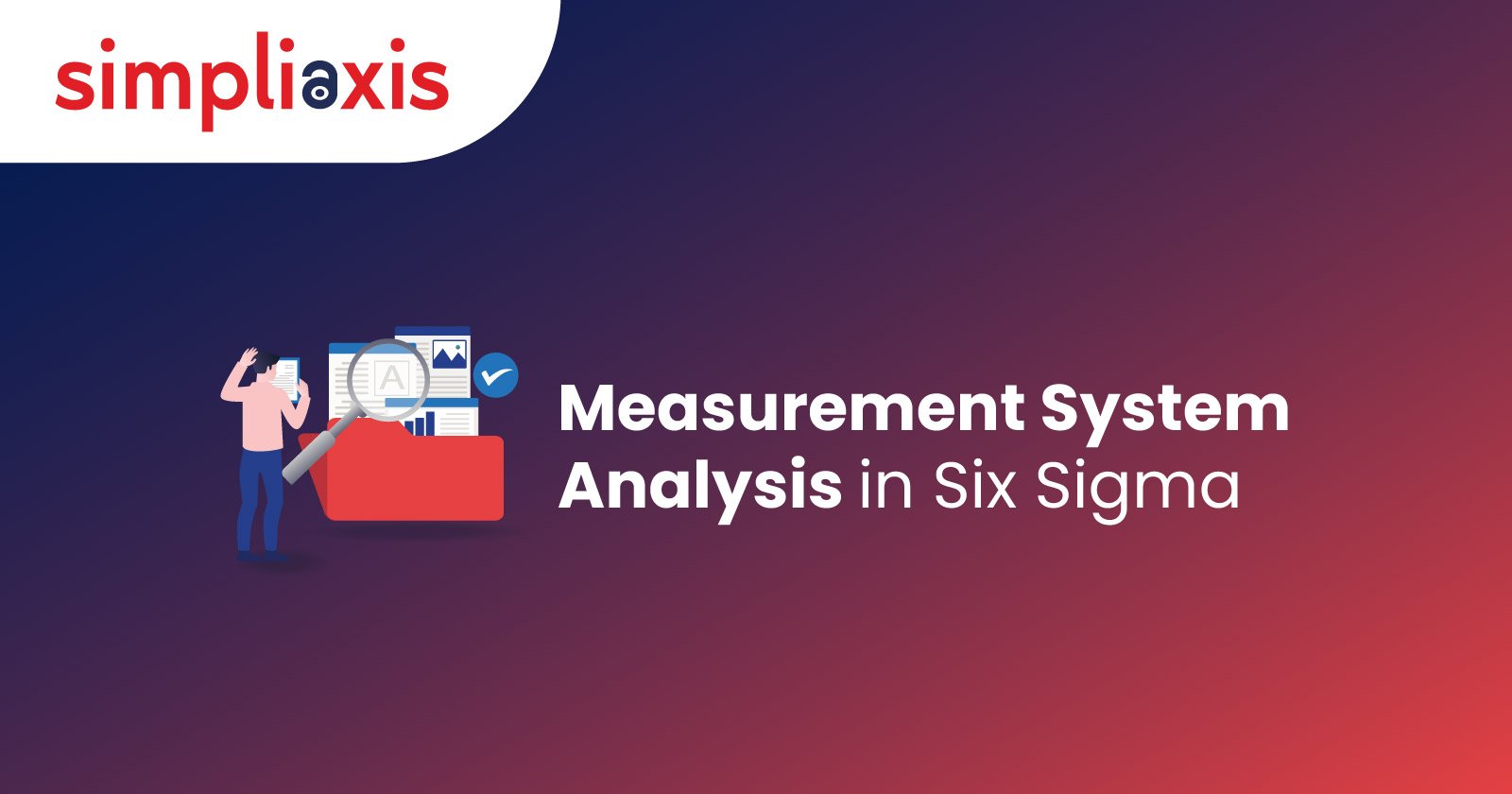Introduction :-
Any organization engaged in the production of a product gathers a huge amount of data on processes and systems every day. Then, the data collected informs decisions for different departments of the organization. The decisions include equipment required, hiring, and even atmospheric elements. As the data collected will help with many decisions, the data collection should be trustworthy. But how to know the trustworthiness of the data? Thanks to the measurement system. It is the only method to measure the dependability of data.
Measurement Systems – An Introduction:
A measurement system is a group of associated moves that help organizations quantify different characteristics of a process for assessing the accuracy of characteristics. Many organizations quickly put measurement systems into practice. However, many organizations also struggle to keep up with them. In turn, these systems turn out to be obsolete after staying neglected for years together. But, measurement system analysis can help all organizations.
Measurement System Analysis – An Introduction:
Measurement System Analysis, shortly called MSA, encompasses different techniques for evaluating the performance of the measurement system of a manufacturing unit. This analysis is particularly used by many manufacturing units for spotting any difference in the production process. Measurement processes encompass different measures like software or gauges and other sources of potential variation like atmospheric and personnel. The experiments conducted at the time of this analysis will analyze every component of the process. The components include measuring instruments employed in the process, the evaluation techniques, and other measures taken for obtaining measurements.
MSA is an instrument used for evaluating the difference present in every type of test equipment, measurement and inspection. It is the system for evaluating the quality of the measurement system. In simple terms, MSA allows manufacturing units to ensure that the difference in measurement is the least as compared to the difference in the process followed.
When you take the case of the Six Sigma Approach, measurement is the key. In Six Sigma, MSA is a mathematical and experimental method of evaluating how much variation there is within the measurement process. Also, it aids in evaluating how the variation contributes to the entire variability in the process.
An Understanding of Measurement Data and Measurement Variation:
"Measurement data" is a term used for denoting a combination of gauges or tools and techniques and operators employed for obtaining the measurements. In Six Sigma, DMAIC is a tool used for getting rid of defects in a process. It aims at reducing defects by restricting variation. Above all, the total variation is arrived at by combining the measurement variation and process variation.
For instance, let us consider that you are measuring the number of cups of any drink in the production run. Let us say that you are measuring the drink using a measuring cup without any accurate measurements in it. But your co-worker uses an accurate measuring cup. In this case, the measurements of both of you will be different. The collective difference between the measuring cups you both used is called measurement variation.
In another example, let us imagine that a call center has auditors for reviewing the quality of the calls handled by each associate. Let us believe that the pay of associates will differ based on the grades given by the auditors. When every auditor uses a different method of grading, there would be a lot of differences in that measuring technique. There will be a difference in the salary as well, won’t there?
What Does MSA Consider in Six Sigma?
When it comes to MSA Six Sigma, the analysis considers the following factors:
- Selection of the right approach and measurement
- Evaluating the measuring device
- Assessment of operators and procedures
- Evaluation of any measurement iterations
- Evaluating the measurement uncertainty of every measurement device and/or measurement system.
Common Tools and Techniques of MSA:
The measurement system analysis Six Sigma uses some common techniques and tools. Some of them include destructive testing analysis, Anova Gage R & R, Gage R & R, attribute gauge study, components of variance, fixed effect Anova and calibration studies. The tool to choose is generally identified based on the characteristics of the measurement system itself.
Benefits of MSA:
MSA Lean Six Sigma can bring a lot of benefits to the production firm that follows Six Sigma practices:
Better Data-Driven Decisions:
When you arrive at decisions based on dependable and good data, you can gain confidence that you have understood the processes and customers better. So, you can take steps to optimize the organizational outcomes.
Spotting Small Changes in the Process:
With Lean Six Sigma Measurement System Analysis, you can observe small changes in your process. When you observe, you also get the opportunity to intervene in between if required and can take action. When taking action, you will have a couple of options. Yes, you can remove something negative or you can implement something positive.
Performance Measurement:
With Measurement System Analysis, you will gain confidence in your measuring system. It means that you can be confident that any conclusions and claims that you have regarding data are statistically and scientifically valid.
Having trustworthy data is important for any decisions you make. When you follow Six Sigma practices, you should have valid data for getting rid of defects. Further, with MSA, you can get to know the reality of the processes that you follow. With the business world moving toward data as the base for decision making, Measurement System Analysis gains more and more value.
Basics of Measurement System Analysis:
If you plan to follow MSA Six Sigma, knowing the basics of this analysis will help:
- One of the basic elements of MSA is to identify the number of assessors. Determine the number of sample parts and the number of repeat readings. You can get confident answers with repeat measurements and a larger number of pieces. Nevertheless, you should weigh the benefits against disturbance, expense, and time needed.
- When using assessors, make sure that they have complete knowledge of the methods. Also, make sure that you choose assessors who make measurements regularly.
- Also, it is better to make sure that the assessors adhere to the documented and standard measuring technique.
- To describe the entire process spread, select the sample elements rightly. This is a crucial part of MSA Six Sigma. The measurement error might be exaggerated if the process spread is not reflected properly.
- Further, you should ensure that the measuring instrument has sufficient resolution/discrimination.
- The assessors should not be aware of the number assigned to every part or any prior measurement value, as the parts should be numbered and measurements are to be done in random order. It is better to make sure that a third party has a table with trial numbers, appraisers, dimensions, and numbers for each part.
Now, when you wish to do a measurement system analysis using Six Sigma, here is the procedure to follow in the Gage R & R Study method:
The Procedure of MSA: Gage R & R Study:
Let us consider that a thermal control company uses a software program that is programmed for cutting a piece of metal to 12 inches. This piece of metal will, in due course, eventually turn out to be a housing for thermal control. With this idea, it is highly crucial that the initial piece of metal should be measured rightly every time. As a part of the quality control process, the company has created a measurement system in which the line operators pull pieces of metal randomly. They pull metal pieces off the line for measuring them using a digital length gauge. In turn, the ability of the machine to accurately cut the metal will improve. But, in this case, how do these operators know that they can depend on their digital length gauge? They decide to do the Gage Repeatability and Reproductive Study, shortly called Gage R & R. Here are the steps involved in this process:
Identify the Type of Data Collection:
In this case, the manufacturing unit wishes to know if there is any difference in the measurement of each piece of metal. This is referred to as variable data. It means the probability of variation between samples exists.
Sample Collection and Selection of Operator:
The next step in this process is to gather a random sampling of the sheet metal at the time of any given production run. Here, it is crucial to get a minimum of 10 samples. Once the random selection of samples is done, it is better to choose three operators, who will be responsible for regularly doing the measurement system process for taking part in the study. Prior to the instigation of the study, the sampled pieces of metal are given appropriate names with details of lengths with their appropriate lengths. However, operators do not know the presence of these labels.
Measurement Process:
When you take the example of metal cutting, 10 samples of sheet metal casings are taken as samples. Each operator will evaluate the sample casings and record the data. Every operator will evaluate the same random sampling to ten sheet metal casings three times, thereby making a total of 30 measurements. Finally, the study organizer will arrange the sample set between every operator for getting rid of potential bias.
Calculations:
In MSA Lean Six Sigma, every operator would have completed all three rounds of measurements at this stage. The organizer of the study will compare every set of measurements to three areas of evaluation. Initially, the organizer will compare every measurement to a master value. Next, the organizer will compare the measurement of every operator across all three rounds. Here, the comparison of every operator to themselves is done. This is referred to as within variation. Finally, the organizer will compare the measurement of every operator to the appraiser’s measurement of the other operator. This is referred to as among-group variation.
Simpliaxis is one of the leading professional certification training providers in the world offering multiple courses related to Quality. We offer numerous Quality related courses such as Lean Six Sigma Yellow Belt Training,Lean Six Sigma Green Belt Certification Training, Lean Six Sigma Black Belt Certification Training, Root Cause Analysis (RCA) Training, Six Sigma Fundamentals Certification Training and much more. Simpliaxis delivers training to both individuals and corporate groups through instructor-led classroom and online virtual sessions.
















